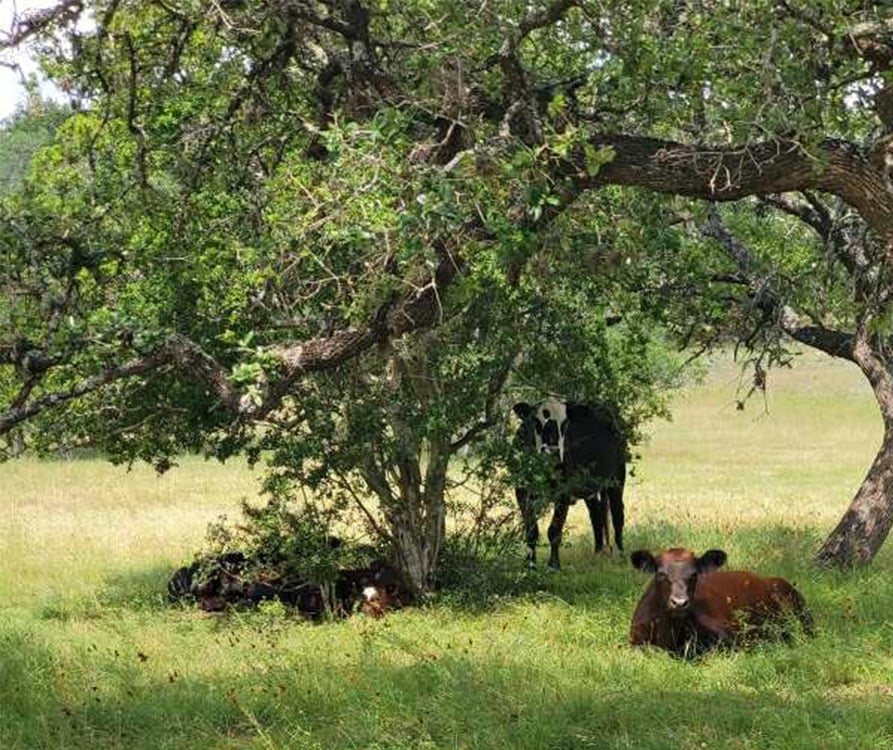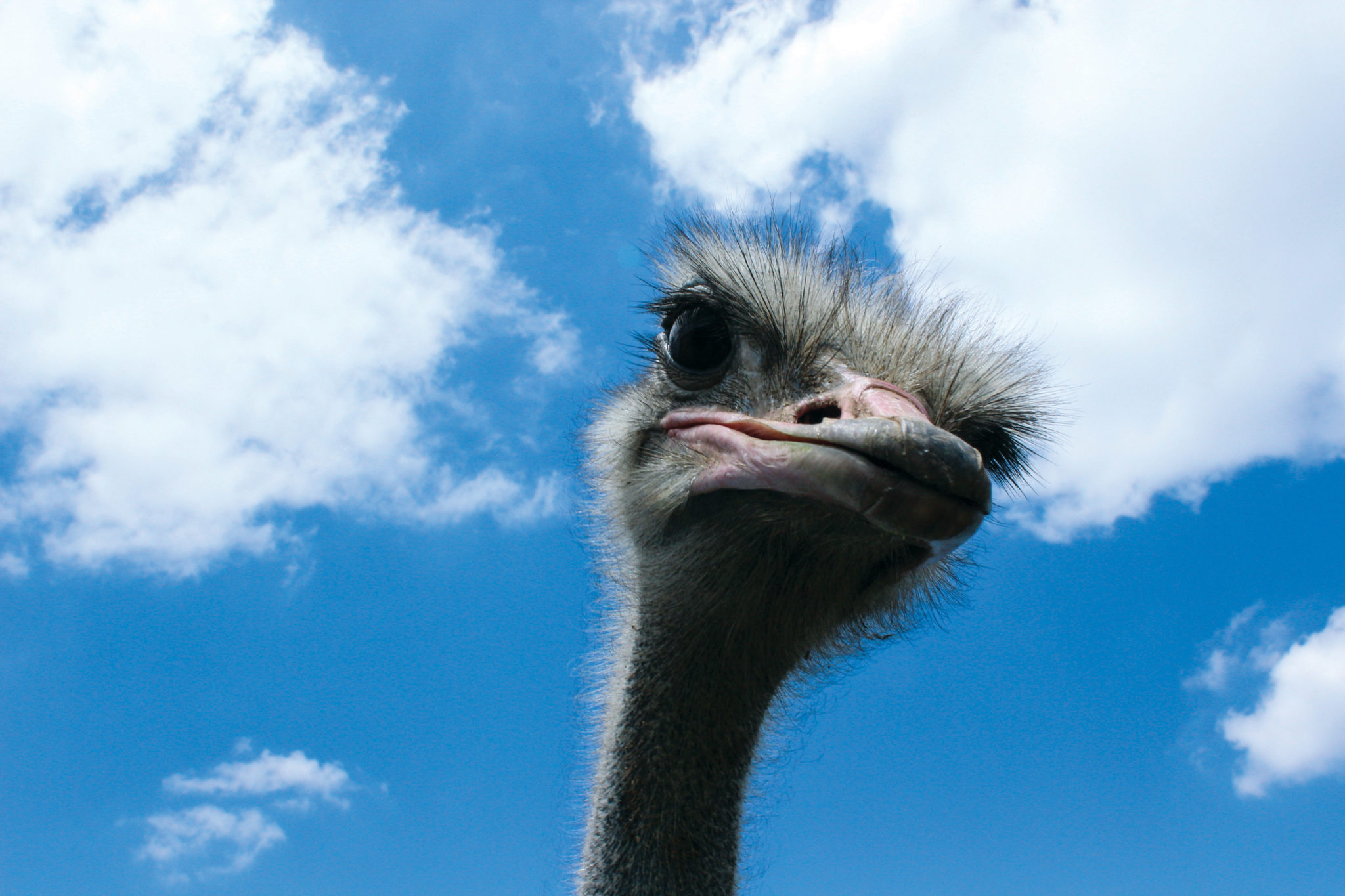
Feathering Their Nest
A Cottonwood family resurrects the once-hot business of raising ostriches.

A version of this story ran in the July 2016 issue.
There’s nothing particularly remarkable about the Kaufman County countryside on either side of Highway 34. The towns along the road are tiny rural communities, notable for the occasional historic building — and not much else. But saunter down a dusty ranch drive in Cottonwood, past the cows and through a gate, and you’re met by some long-necked residents that have put this town of 185 people on the map.
This wobble of ostriches, easily the best collective noun for them, belong to Don and Sharon Birmingham, a husband and wife team who are trying to generate a resurgence of the American ostrich industry.
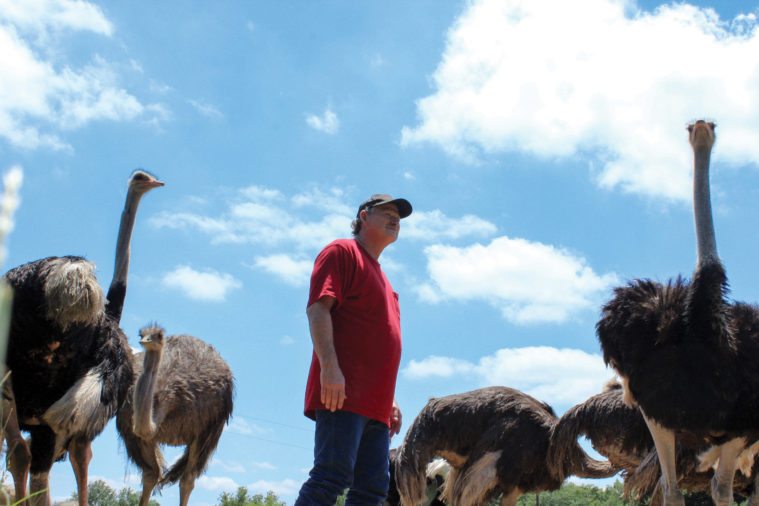
Don built the family home on 40 acres of pastureland and cypress trees in the late 1980s, after the couple moved from Dallas. He became fascinated by ostriches when he watched Tarzan movies as a kid. (Sharon rolls her eyes as he tells me this.) At first, she thought her husband was crazy. Today, after careers in a congressional office and processing disability claims, Sharon works full time on the farm, incubating and hatching new birds. The Birminghams’ three-year plan: to double the number of their birds to 50 so they can begin supplying restaurants with meat.
While the industry peaked in the 1990s, inflated prices for birds and eggs exposed it to corruption and market instability.
Something feels slightly wrong about sitting a few feet from a pen full of ostriches and discussing their various uses as corpses. But so it goes on a warm, humid morning in May when I visit the Birminghams’ farm. Ostrich skin is used for leather boots, purses, wallets and belts. The feathers, once a big fashion item, are employed more often these days as dusters in the electronics industry, as they can reach hard-to-access parts. The meat — now selling wholesale for $12 to $18 per pound, according to Don — is noted for being a leaner alternative to beef. The oil “has medicinal qualities,” Don says. “When we have cuts, we put it on and it heals much more quickly.” And the leg bones are turned over to one of the Birminghams’ dogs.
“That’s Jack over there — he’s 10,” Don says, pointing to an ostrich that to me looks no different from the others. Jack follows Don around the field and fends off other males if they get too close. Don grabs a metal pole with two wide prongs that’s propped against the fence. “When I go in there to get the eggs, that one will try to kick me the whole way,” he says. “I have the pole to keep him off.”
Don has been attacked once, in the mid-1990s. “It was our first egg and we were all excited,” he says. “I went over with a bucket and a male charged at me, kicked me in the side.”
“It was 1994,” Sharon adds. “I know that because I was pregnant at the time with Tanner and I’ve never seen a human drop-kicked like a football before.”
Ostriches attack by keeping one foot on the ground and using the other to kick out, karate style. They can slice through human skin with their huge, razorblade-like clawed toes. “I’ve heard of them gutting people,” Don says. “They can get real aggressive during breeding season.”
Despite this fierce side, Sharon says, the birds get to know people, and because Don and their sons, Tanner, 21, and Seth, 16, spend so much time in the pens, the ostriches are good-natured with them. The birds evidently know the mantra: Don’t bite the hand that feeds you.
Nearby, Tanner and Seth feed bales of alfalfa into a grinder. The alfalfa is combined with soybean, corn, minerals, vegetable oil and oyster shells to help the ostriches’ digestion. “It’s a recipe we stick to, so they get the proper nutrition,” Tanner says.
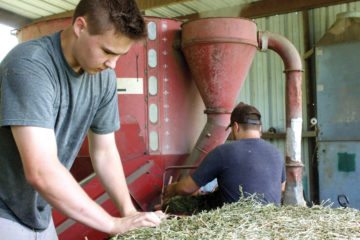
Near the ranch house is a large metal barn. Inside, heat lamps suspended from wooden beams hover inside a pen. In the pen are about 20 chicks running around on alfalfa grass. Tanner hops the fence and picks one up, passing it to me. I can feel its heartbeat and the hard, spiny feathers on its back. It’s strong and tries to escape, pushing its feet into the palm of my hand.
Below me, in the pen, one of the Birminghams’ dogs herds the chicks into a corner. In the next room is the hatchery: several large incubators kept at 97.5 degrees and 14 percent humidity. About 80 huge eggs sit in rows, and the machines turn them every four hours. After 40 days, about 60 percent of the eggs will hatch. Seth and Tanner will blow the yolk out of the infertile eggs, and the Birminghams will sell the shells for about $20 each. “An artist from New York recently bought some from us,” Sharon says. “She does some amazing work.” Sharon says she’s had inquiries from artists wanting to make pysanky, ornately decorated eggs popular in Ukraine.
Texas’ climate is conducive for raising ostriches. During hot summers, Don says, they “sit with their backs to the wind and their wings outstretched — it’s their cooling system.”
Originally from Africa, ostriches were brought to the United States in the late 1800s, their feathers used in the fashion industry. American “feather barons,” as they were known, gambled on a notoriously fickle industry. Some made their fortune; others watched the market collapse when feathers became last season’s fashion news. Joel Brust, president of the American Ostrich Association and an ostrich farmer in California, told the Observer that one of the things that killed the industry was the arrival of the automobile (feather hats just didn’t work in open-top cars). The economic upheaval following the advent of World War I also precipitated the industry’s decline. The business resurged in the 1980s after breeders discovered that ostrich meat tasted like beef but was lower in fat. At that point, the world’s biggest producer was South Africa. Then in 1986, the United States passed the Comprehensive Anti-Apartheid Act, which banned trade with South Africa. The subsequent short supply of ostriches jacked up prices. American farmers decided to get in on the act, and Texas and Oklahoma became dominant in the industry. In the late 1980s, Fort Worth farmer Tom Mantzel founded the American Ostrich Association.
After the anti-Apartheid act was repealed during the first Bush administration, the United States once again permitted South African ostrich imports. Both supply and demand increased, giving rise to what media described as an ostrich-breeding boom. Americans were jumping into get-rich-quick schemes based on breeding and selling live birds. The Dallas Morning News noted in a 1990 article that the money was “in the mating,” partly because the population of ostriches needed to increase before it could sustain a meat production industry. A pair of adult breeding birds could command up to $50,000 — an increase of 500 percent in four years. “It was crazy,” Brust said.
People were buying chicks and eggs and raising them for a few months to sell to other people interested in high-profit breeding. Or they bought adult birds only to turn around and sell them at a profit shortly afterward. It was a breeder’s market, in theory until there were enough ostriches to supply the meat industry. Brust said people got into the industry with no intention of creating long-term ostrich farming businesses. Instead, “they acted more like brokers,” he said. “All they had to do was get a few chicks to hatch, since the price of birds as they got older just escalated beyond anything that made any sense.”
The astonishing figures ostriches could command attracted criminals. In June 1991, thieves stole 50 ostrich eggs worth $100,000 from a breeder in Weatherford. The breeder, Connie Bordelon, told the Fort Worth Star-Telegram that some of the eggs were worth $3,000 each. Police found the eggs a month later through what one quick-witted writer at the Austin American-Statesman referred to as “hard-boiled detective work.”

In 1993, the American Ostrich Association estimated there were 50,000 ostriches in the United States on 3,500 farms. For the first time, ostrich breeders staffed a promotional booth at the State Fair of Texas; the state had become the country’s biggest producer with 800 farmers. But according to a 1994 story in the Star-Telegram, while the market for ostriches was feverish, so were “pie-in-the-sky investments.” One agricultural economist told the newspaper that ostrich investments were like junk bonds — “high profit, but high risk.” The ostrich rustler had been replaced by the scam artist, the Star-Telegram continued, “particularly telemarketers who offer chicks at several thousand dollars a pair but never deliver.”
In August 1995, the Securities and Exchange Commission filed a complaint against a Dallas firm, International Breeders Inc., for using “high-pressure, boiler room sales tactics” to raise as much as $6.5 million from 700 investors. The SEC said the firm failed to disclose that investing in ostrich breeding was “high risk” and “highly speculative.” Newsweek later reported that most investors did not see any returns.
With a surfeit of live ostriches produced by the breeding boom, the bottom started falling out of the market. “The market got so saturated with chicks and nobody was creating the infrastructure to process the meat,” Sharon Birmingham says. “There was no distribution. So it hit a roadblock.”
By 1995, the price of a breeding ostrich pair had plummeted. According to the American Ostrich Association, brokers were stuck with birds they could no longer sell for a profit; ranchers sold birds off cheaply, driving prices down further. “I think there were a lot of genuine people in the industry that were truly trying to build it up long term to produce meat,” Sharon says. “But the dollar got in the way — sadly.”
By 1995, the U.S. Department of Agriculture had started inspecting some ostrich processing plants, though most were still inspected at the state level. Federal inspections removed a huge barrier to expansion of the industry, especially for producers hoping to export meat. But there was still a dearth of production and distribution facilities, and the supply of ostrich meat was unsteady. Restaurants that had been serving up ostrich burgers, steaks and even sausages — the new healthy alternative to beef — started removing the product from their menus.
The Birminghams, with two young children taking up much of their time, decided to get out of the industry. But something in Don’s mind told him they’d be back.
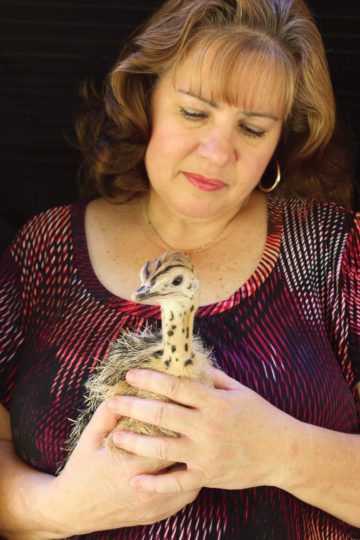
Robert Cavo got into the ostrich business in 1989 when, in his words, “it was very hot.” He runs R&M Ostrich Farm in Taylor, which hatches and raises chicks to sell to farmers wanting to grow birds to slaughter for meat and leather. “A lot of people got out of the industry in the late ’90s — people who were in it for the money only,” Cavo says. “I’ve seen the good, the bad and the ugly. … Today, most people getting into the business are hands-on, and the industry, it’s getting back to being good again.”
In a measure of how much the industry has declined since the 1990s, there were 258 ostrich farms in the United States in 2012, according to the USDA, compared to 1,643 a decade before. In Texas, there were 44 farms in 2012, a decline from 279 farms 10 years earlier.
Brust claims the industry has been on the upswing in recent years but would not provide numbers that could measure the growth.
“I can say that more product is now available to the meat market, but the association does not publish the number of members it has,” he said. “Back in [the 1990s], when everybody knew how much the [association] was growing, it helped contribute to the growth of the wrong industry. So we don’t think it’s in the best benefit of the industry to publish numbers now. It sends the message that everyone should start raising ostriches. And they shouldn’t.”
Cavo, who was in the grocery business before diversifying into ostriches, says he’s been successful largely because of marketing. “We’ve been on the internet for 25 years. I believe it’s going to go just like the chicken or turkey industry,” he says. “But we need herds everywhere for it to be a realistic industry. If McDonald’s wants ostrich burger on the menu, they’re going to want farmers to guarantee 50 tons of ostrich meat a year. So we’re not currently where we need to be as an industry — there are not enough people, birds.”
But Cavo is optimistic: “It’s a very realistic business and I’ve been in it a long time.” So, too is Don Birmingham. A few years ago, he told Sharon he’d like to raise birds again, just to provide meat for the family. But it wasn’t long before he was struck by visions of ostrich meat on dinner plates all over America. “We went to a breeder, supposedly to look at 6-month-old birds,” Sharon says, “but when we got there he saw some breeder birds in the distance and walked right by the 6-month-olds. We wound up buying the bigger breeder birds.”
Though production still doesn’t meet demand for domestic ostrich meat, the industry has learned important lessons, Don says. “And we’ve now got local places that are processing meat,” Sharon says. Some Texas restaurants, including Twisted Root Burger Company, put ostrich back on the menu.
Her son, Tanner, stands at a smoker in the front yard of the Birmingham ranch, pulling out strips of cooked ostrich meat and placing them on a plate. Inside, deer heads peer from the walls, and a plume of ostrich feathers sticks out from next to a boar’s head. At the dinner table, Sharon serves ostrich meat fajitas with warm corn tortillas and homemade salsa, and it tastes delicious. Don says you can get anywhere from 80 to 100 pounds of meat from an ostrich, depending on the size of the bird.
“Americans can be squirrely about trying different food,” Sharon says, “but worldwide, people eat so many different things compared to what we will even try.” She volunteers as treasurer of the American Ostrich Association. After the dark days of the 1990s, the association is trying to bring a level of trust to the industry, she says. They have a new website, where buyers can search for suppliers. In the ’90s, Sharon says, it was done largely through word of mouth. “The industry is trying to raise animals for meat so there will be a steady supply,” Don says. “And buyers will be able to see where that meat is coming from, where it’s being processed. Before, our nearest processing plant was Kansas City. Now it’s Temple. So people locally are starting to realize that ostrich meat is a viable alternative.”
